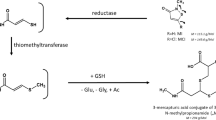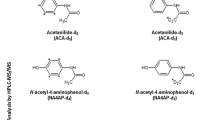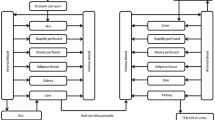Abstract
Methylisothiazolinone (MI) as well as the mixture of chloromethylisothiazolinone/methyl-iso-thiazolinone (MCI/MI, 3:1) are widespread biocides used in personal care products with potential consumer exposure. Their use is currently under discussion because of rising rates of skin sensitization against these substances in the general population. We have examined the human metabolism of methylisothiazolinone and chloromethylisothiazolinone after oral dosage of stable isotope-labelled analogues. Four human volunteers received 2 mg of labelled MI and MCI separately and at least 2 weeks apart. Consecutive and complete urine samples were collected over 48 h and were examined for the content of N-methylmalonamic acid (NMMA), a previously reported animal metabolite. NMMA represented 23.7 and 13.3% of the dose excreted in urine after dosage of MI and MCI, respectively, with more than 90% excreted within the first 24 h. Excretion of NMMA was rapid with mean half-lives of 6.1 and 7.6 h for MI and MCI, respectively. We have for the first time determined important human toxicokinetic data for the biocides MI and MCI that might be of relevance in future exposure and risk assessments.





Similar content being viewed by others
References
Aerts O, Meert H, Goossens A, Janssens S, Lambert J, Apers S (2015) Methylisothiazolinone in selected consumer products in Belgium: adding fuel to the fire? Contact Dermat 73:142–149. doi:10.1684/ejd.2015.2608
Berthet A, Spring P, Vernez D, Plateel G, Hopf NB (2017) Ex vivo human skin permeation of methylchloroisothiazolinone (MCI) and methylisothiazolinone (MI). Arch Toxicol. doi:10.1007/s00204-017-1978-x (in press)
Burnett CL, Bergfeld WF, Belsito DV, Klaassen CD, Marks JG, Shank RC, Slaga TJ, Snyder PW, Alan Andersen F (2010) Final report of the safety assessment of methyl-iso-thia-zo-linone. Int J Toxicol 29(4 Suppl):187S–213S. doi:10.1177/1091581810374651
Du S, McLaughlin B, Pal S, Aizenman E (2002) In vitro neurotoxicity of methylisothiazolinone, a commonly used industrial and household biocide, proceeds via a zinc and extracellular signal-regulated kinase mitogen-activated protein kinase-dependent pathway. J Neurosci 22(17):7408–7416
Fichtl B, Starke K (2001) Arzneistoffkonzentration im organismus in abhängigkeit von der zeit: pharmakokinetik im engeren sinn. In: Forth W, Henschler D, Rummel W, Förstermann U (eds) Allgemeine und spezielle pharmakologie und toxikologie, 8. Auflage. Urban und Fischer Verlag, München, pp 56–77
Garcia-Hidalgo E, Sottas V, von Götz N, Hauri U, Bogdal C, Hungerbühler K (2017) Occurence and concentrations of isothiazolinones in detergents and cosmetics in Switzerland. Contact Dermat 76(2):96–106. doi:10.1111/cod.12700
Giménez-Arnau AM, Scientific Committee of Consumer Safety (SCCS) (2016) Opinion of the Scientific Committee on Consumer safety (SCCS)—Opinion on the safety of the use of Methylisothiazolinone (MI) (P94), in cosmetic products (sensitisation only). Regul Toxicol Pharmacol l76:211–212. doi:10.1016/j.yrtph.2016.01.001
Hartwig A (ed) (2013) The MAK Collection for Occupational Health and Safety: 2-Methyl-4-isothiazolin-3-one (MAK value documentation)., pp 1–26. doi:10.1002/3527600418.mb268220kske5515
He K, Huang J, Lagenaur CF, Aizenman E (2006) Methylisothiazolinone, a neurotoxic biocide, disrupts the association of SRC family tyrosine kinases with focal adhesion kinase in developing cortical neurons. J Pharmacol Exp Ther 317(3):1320–1329
Larsen K (1972) Creatinine assay by a reaction-kinetic principle. Clin Chim Acta 41:209–217
Latheef F, Wilkinson SM (2015) Methylisothiazolinone outbreak in the European Union. Curr Opin Allergy Clin Immunol 15:461–466. doi:10.1097/ACI.0000000000000208
Lessmann F, Schütze A, Weiss T, Langsch A, Otter R, Brüning T, Koch HM (2016) Metabolism and urinary excretion kinetics of di(2-ethylhexyl)terephthalate (DEHTP) in three male volunteers after oral dosage. Arch Toxicol 90(7):1659–1667
Lundov MD, Kolarik B, Bossi R, Gunnarsen L, Johansen JD (2014) Emission of isothiazolinones from water-based paints. Environ Sci Technol 48:6989–6994. doi:10.1021/es500236m
Reinhard E, Waeber R, Niederer M, Maurer T, Maly P, Scherer S (2001) Preservation of products with MCI/MI in Switzerland. Contact Dermat 45(5):257–264
Scherer M, Koch HM, Schütze A, Pluym N, Krnac D, Gilch G, Leibold E, Scherer G (2017) Human metabolism and excretion kinetics of the fragrance lysmeral after a single oral dosage. Int J Hyg Environ Health 220(2):123–129. doi:10.1016/j.ijheh.2016.09.005
Schettgen T, Bertram J, Kraus T (2017) Quantification of N-methylmalonamic acid in urine as metabolite of the biocides methylisothiazolinone and chloromethylisothiazolinone using gas chromatography-tandem mass spectrometry. J Chromatogr B 1044–1045:185–193
Scientific Committee of Consumer Safety (SCCS) (2009) Opinion on the mixture of 5-chloro-2-methylisothiazolin-3(2H)-one and 2-methylisothiazolin-3(2H)-one (P56). SCCS/1238/09, Adopted at 08 December 2009. http://ec.europa.eu/health/scientific_committees/consumer_safety/docs/sccs_o_009.pdf. Accessed: 08 June 2016
The European Parliament (2009) Regulation (EC) no. 1223/2009 of the European parliament and of the council of 30 November 2009 on cosmetic products. Official Journal of the European Union, L 342/59ff
Acknowledgements
The development of the analytical method and its first application in a human metabolism study are part of a large-scale 10-year project on the advancement of human biomonitoring in Germany. This project is a cooperation agreed in 2010 between the German Federal Ministry for the Environment, Nature Conservation, Building and Nuclear Safety (BMUB) and the Verband der Chemischen Industrie e.V. (German Chemical Industry Association—VCI) and is managed by the German Environmental Agency (UBA). In this cooperation project, the analytical method development and the human metabolism study are financed by the Chemie Wirtschaftsförderungsgesellschaft mbH by a grant to the University hospital of RWTH Aachen University. Experts from governmental scientific authorities, industry and science closely accompany and advise the project in selecting substances and developing methods.
Author information
Authors and Affiliations
Corresponding author
Ethics declarations
Ethical approval
The study design was in accordance with the ethical standards of the institutional and/or national research committee and with the 1964 Declaration of Helsinki and its later amendments or comparable ethical standards. Approval for the study protocol was obtained from the Ethics Commission of the Faculty of Medicine of the RWTH Aachen University, Germany (Reg. no. EK 336/14). Written informed consent was obtained from all individual participants included in the study.
Electronic supplementary material
Below is the link to the electronic supplementary material.
Rights and permissions
About this article
Cite this article
Schettgen, T., Kraus, T. Urinary excretion kinetics of the metabolite N-methylmalonamic acid (NMMA) after oral dosage of chloromethylisothiazolinone and methylisothiazolinone in human volunteers. Arch Toxicol 91, 3835–3841 (2017). https://doi.org/10.1007/s00204-017-2051-5
Received:
Accepted:
Published:
Issue Date:
DOI: https://doi.org/10.1007/s00204-017-2051-5




